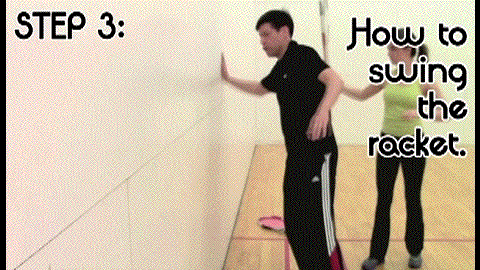29 - Modern Forehand - From hi-techtennis.com - Lesson 4: The Pull, the Slot, and the Arc - Rotate the Hand Backwards and Pull Through the Slot
The Slot and "Pulling the Towel"
The Biomechanics
Rotate the Hand Backwards and Pull Forward
My idea is has to do with the slight external which means lateral (which is the same as outwards) rotation of the shoulder blade, upper arm and supination of the forearm, and hand that I observe occuring on the forward swing. This is a point that I think is really important. It accomplishes several things--it naturally brings the elbow in closer to the body, it causes the elbow to start to lead and come forward, it causes the wrist to lay back and the racket head to trail the wrist and it causes the ball to be struck out in front.- Gary Adelman
(from an email to Jeff 2006)
Gary emailed me in back in 2006 explaining his insight into the biomechanics of the forward swing of a modern forehand. At first I couldn't see what he was talking about. But after looking at my video archive for awhile - especially the high speed videos - it became obvious that he had discovered the biomechanics behind the modern forehand. All good forehands involve this backwards twist of the hand combined with a pulling forward of the arm. And it is exactly as Gary describes it.
Typically you will hear or read about the "stretch shortening cycle", where the wrist flexes backwards so it can then release, like a spring, forward into the ball. This is true. However there is a much bigger picture going on that Gary is describing. By twisting your forearm and wrist backwards (arm supination) as you pull forward, you are actually externally rotating the arm from the shoulder. This is also called supination. This does a number of things as Gary mentions. It causes the upper arm to lead and pull forward, while the racket and hand trail behind. This assures contact in front of the body. The winding backwards of the wrist and the shoulder (through arm supination) will add a burst of speed just before contact when you relax and let these wound up muscles and tendons spring forward.
As you watch the video above, get a sense of the winding up motion of the arm and hand. Watch how energy is being stored up in the form of a coil, or wound up spring, in the foarearm. And also notice how the upper arm is getting pulled forward (the elbow moves in front of the body plane) as this winding occurs. This guarantees out in front contact (leverage).
Finally, check out this exercise. I discovered this gem on http://www.howtoplaytennisvideos.com. I don't know who the instructor is, but this exercise he has in his video is spot on. It guarantees you externally rotate the shoulder, supinate the arm to get the hand and forearm to twist backwards, and then pull the upper arm forward in front of the body plane. Notice how his hand is dragging behind due to the motion. This lag and twisted back arm is critical to the stroke because a simple relaxtion will get the lagging racket and wrist to spring forward.


Comments
Post a Comment